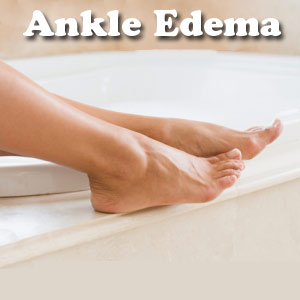Ankle Edema

A sign of fluid buildup or inflammation of joint and tissue, ankle swelling is also called edema. It can also result from serious infections, trauma or circulatory disorders, cardiac disorders or other conditions. Mild ankle swelling is often a common occurrence after long bouts of standing.
Of course, painless swelling of the ankles is a common problem among older people. Swollen ankles can be indicative of potentially serious disorders such as congestive heart failure, deep vein thrombosis and liver failure. Pregnancy, obesity, vascular problems or orthopedic conditions are other possible causes for ankle edema.
If you experience ankle swelling with chest pain, dizziness, light-headedness, confusion, shortness of breath, or any difficulty in breathing, seek immediate medical attention. Ankle edema is not a disorder but a symptom of another underlying condition.
Causes for ankle swelling
Ankle swelling is common in the following conditions:
- Obesity
- Blood clots in the leg
- Age
- Leg infection
- Veins in the legs that cannot properly pump blood back to the heart.
- Leg or pelvic surgery
Foot or ankle injury such as a sprain is a common cause for swollen ankles. This occurs due to injury to the ligaments holding the ankle. There are times when long flights or car rides and standing for long periods of time can lead to swelling of ankles. Many women notice ankle swelling during pregnancy. It is complicated by preeclampsia, a serious condition that includes high blood pressure and swelling.
Certain medications, like antidepressants, calcium channel blockers and hormones like estrogen and testosterone and steroids can cause swelling. Swollen legs are often a sign of failure of heart, kidney and liver. This is an indication of too much fluid in the body. Gout is caused by accumulation of uric acid crystals within the fluid of the ankle. Those suffering from gout exhibit abnormal accumulation of uric acid within the joints leading to inflammation and resultant swelling.
Ankle arthritis is another degenerative change of the joint which can be quite painful and could cause swelling. Blood clots, known as DVT (deep vein thrombosis), are a common vascular obstruction of blood flow which can cause swelling around the ankles and can also extend further up the leg. Lymph edema or collection of lymphatic fluid in the tissues can cause ankle edema. This can occur when there is a blockage to the lymph nodes. This is common with patients suffering cancer or undergoing radiation therapy. Possible symptoms that occur with ankle swelling include fatigue, joint stiffness, redness in the ankle join and reduced range of movement.
Potential complications and treatment for ankle swelling
Treatment for ankle edema depends upon the analysis of the underlying disease condition and its diagnosis.
- Keep ankle lifted so that the leg falls on a straight line. An ice pack can be applied on the raised ankle.
- Reduce intake of salt. Cut down on processed food especially fast foods that are high on salt.
- To soothe tendinitis, sprains, strains and aches, alternate hot and cold vinegar wraps can do wonders. Heat equal amounts of vinegar and water, soak a towel and wrap it around the foot for about five minutes. Now mix equal parts of vinegar and cold water and follow the same procedure. Repeat this sequence thrice.
- Ice can be applied to a sprain for about 15 minutes daily and every two hours for about two days to reduce bleeding, inflammation and pain.
- Drink plenty of water as it moves through kidneys, bladder, diluting the urine. Since urine has some fluid-retaining salt in it, the more it is diluted, the easier it is to remove salt and prevent edema.
- Exercise like walking or swimming can help.
- Support stockings can be worn.
- Avoid wearing tight clothing or garters around thighs.
- Lose weight if you need to.
- A few yoga poses might help the circulation and ease the ankle edema.
- Soak your feet in warm salt water; preferably Epsom salt. Alternatively you can try a few drops of peppermint oil or grapefruits oil in warm water.
- A massage therapist might be able to relieve swollen ankles with reflexology.
Top of the Page: Ankle Edema
Tags:#ankle swelling #ankle edema #ankle swelling causes #treating swollen ankles
 Healthy Habits for Women
Healthy Habits for Women Obesity indicator - ABSI Calculator
Fighting Diabesity
Depleted Immune System
Gonzalez Regimen for Cancer
Irritable Bowel Syndrome
Inflammatory Bowel Disease
Healthy Eating Habits
Diabetes Prevention Tips
Ankle Edema
Deep Vein Thrombosis
Colon Cleansing
Women and Substance Abuse
Water Retention Causes
Improving Blood Circulation
More on Women Health
 Shortness of Breath
Shortness of Breath Eosinophilic Esophagitis
Feminine Hygiene
Nail Fungus
Antidepressants and Weight Gain
Iron deficiency Anemia
Avian Flu Pandemic
Mood swings and women
Medical Alert Devices
Hypokalemia
Metabolic Syndrome X
Heat Stroke
Altitude Sickness
Body Sculpting
Gout Symptoms
Polymyalgia Rheumatica
Systemic Lupus
Reflex Sympathetic Dystrophy
Carcinoid
Chronic Sciatica
Diet and Kidney Disease
Loss of Appetite
Suppress Appetite
How to Improve your Memory
Short Term Memory Loss
Leg Cramps at Night
Top of the Page: Ankle Edema
Popularity Index: 102,605

